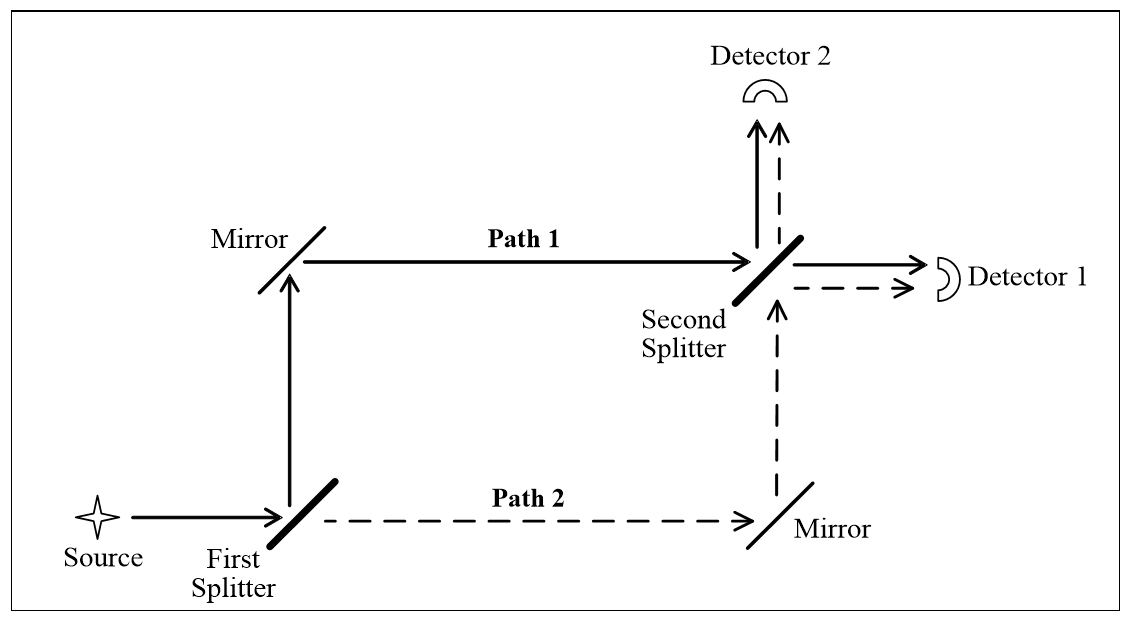Quantum theory allows experimenters to detect an object without observing it physically in any way. This should be physically impossible but in our world it isn’t. The setup to do this is shown in Figure 3.22.

A light source shines on a beam splitter that sends half the light down path 1 and half down path 2, so at this stage the detectors shown each fire half the time. Now a second splitter is added where the two paths meet that splits the light again, half to one detector and half to the other. Now detector 1 registers but detector 2 stays silent. Quantum theory explains this as follows:
As photon quantum waves evolve down the paths, each mirror or splitter delays the phase by half. The two paths to detector 1 have two turns so they are in phase but path 1 to detector 2 has three turns and path 2 has only one so they cancel at detector 2. Detector 2 never fires because the quantum waves from the two paths to it always cancel out.
This setup allows a very unusual result. If an object that registers any light is put on path 2, the previously silent detector 2 sometimes fires without the object registering any light. This never happens if path 2 is clear, so this setup can prove there is an object on path 2 without touching that object.
To recap, the results of this experiment (Kwiat et al, 1995) are:
1. With two clear paths, only detector 1 fires.
2. If a receptor blocks path 2, detector 2 sometimes fires without setting the receptor off.
This setup can detect an object without physically observing it (Audretsch, 2004) p29 and quantum theory explains how:
As photon quantum waves evolve down the paths, those on path 2 are now blocked by a receptor that registers light half the time. Since the path 1 waves to detector 2 no longer cancel out, it fires a quarter of the time even though no light is registered on path 2. The other quarter of the time the path 1 light registers on detector 1. Detector 2 firing proves there is an obstacle on path 2.
To show how strange this is, suppose that unknown to the experimenters, path 2 contains a bomb so sensitive that even one photon will set it off. If they send one photon down the system and get lucky – detector 2 fires to prove the bomb is there. The bomb has been detected without physically touching it in any way, though this is a bad bomb detection technique because half the time it sets the bomb off!
Non-physical detection supports quantum theory but again physical realism can’t explain it at all. If a physical thing is out there, how can we register it without physical contact? How can one photon detect a bomb on a path that it didn’t take?
In contrast in quantum realism, quantum theory is literally true. The photon instances travel along four paths to the two detectors, where Table 3.2 shows the results. Non-physical detection occurs when an instance that travels along path 1 to detector 2 registers a physical event. This result confirms that quantum waves exist but physical realism has no explanation for it at all.
|
Table 3.2. Non-physical detection |
|||
|
Path |
Probability |
Result |
|
|
No Obstacle |
Path 2 Obstacle |
||
|
Path 1 to Detector 1 |
25% |
Detector 1 fires |
Detector 1 fires |
|
Path 2 to Detector 1 |
25% |
Detector 1 fires |
Path 2 registers light |
|
Path 1 to Detector 2 |
25% |
Detector 2 doesn’t fire |
Detector 2 fires but path2 doesn’t register any light |
|
Path 2 to Detector 2 |
25% |
Detector 2 never fires |
Path 2 registers light |